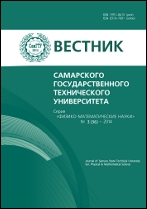|
This article is cited in 1 scientific paper (total in 1 paper)
Mechanics of Solids
Mathematical modeling of deformation of reinforced femur during prolonged static loads
V. P. Radchenko, A. V. Nekhozhin
Samara State Technical University, Samara, 443100, Russian Federation
(published under the terms of the Creative Commons Attribution 4.0 International License)
Abstract:
A two-layer mathematical model of a human femur neck reinforced implants of different design for modeling stress-strain state which occurs during a surgical procedure to prevent femur neck fractures by the forced introduction of metallic implants is proposed. Engineered implant designs are provided. Methods and software for geometric modeling of femur embedded with the implants are developed. New boundary value problems to evaluate kinetics in creep conditions of the stress-strain state of reinforced and non-reinforced femoral neck during prolonged static loads corresponding to human foot traffic are formulated. Effective elastic properties of cortical and cancellous bone, power and kinematic boundary value problems. A phenomenological creep model for compact bone tissue is constructed. The technique of identifying the parameters is developed. A check of its adequacy to experimental data is carried out. Based on the finite element method the numerical method for solving the provided boundary value problems at macro level of continuum mechanics is developed. A lot of variative calculations allowed developing recommendations for the rational positioning of the implant in order to minimize stress concentrations. The performed analysis showed that there is a significant relaxation of stresses in the most loaded areas due to creep. Relaxation is more intense in reinforced femoral neck than in the unreinforced. Thus the tension in the most loaded femoral neck area due to creep is reduced by 49 % with respect to the intensity of the initial time of loading for femur which is reinforced by the spoke-spoke-type implant when loading duration is 1 year under natural loads corresponding to human foot traffic. It was found that the time component (long-term fixed load) does not impair the positive effect of reducing the stress concentration due to a femoral neck reinforcement which is a positive fact from the medical practice point of view.
Keywords:
femur bone, implant, femoral neck, geometric modeling, finite element method, creep, stress-strain state, relaxation.
Original article submitted 04/VII/2015
revision submitted – 18/IX/2015
Citation:
V. P. Radchenko, A. V. Nekhozhin, “Mathematical modeling of deformation of reinforced femur during prolonged static loads”, Vestn. Samar. Gos. Tekhn. Univ., Ser. Fiz.-Mat. Nauki [J. Samara State Tech. Univ., Ser. Phys. Math. Sci.], 19:4 (2015), 768–784
Linking options:
https://www.mathnet.ru/eng/vsgtu1441 https://www.mathnet.ru/eng/vsgtu/v219/i4/p768
|

|




 Contact us:
Contact us: Terms of Use
Terms of Use
 Registration to the website
Registration to the website Logotypes
Logotypes









 Citation in format
Citation in format 
